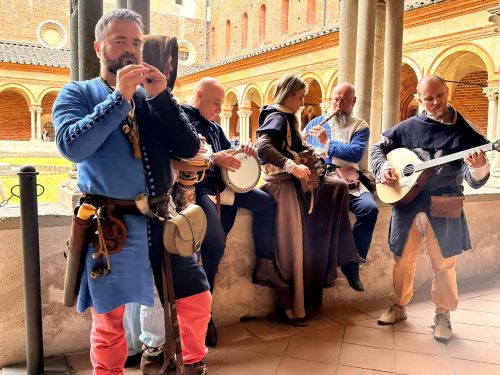Medieval Music
The classical definition of “Middle Ages” indicates the historical period between the fall of the Western Roman Empire (476 AD) and the discovery of America (1492 AD): these dates, purely conventional, delimit an interval of almost a thousand years during which Europe has undergone profound transformations.
In the Middle Ages we witness the birth of musical notation: for this reason, it is now possible to reconstruct (with more or less precision) melodies that, if they had been left only to the oral tradition, would have been lost.
The musical notation is born in the ecclesiastical context, where there was the need to train singers for the so-called Gregorian chant: initially it was graphic signs (neumes) that indicated the melody progression, useful as mnemonic help if the song was already known. Starting from the ninth century the musical line appeared, and with it the systematic notation (it indicates the height of the notes and the amplitude of the intervals), afterwards the notation became more and more rich and complex up to a notation like that we use today.
One of the most precious monuments of medieval music is the corpus of compositions known as Cantigas de Santa Maria, written between 1250 and 1280, commissioned (and perhaps partly also composed) by Alfonso X the Wise, king of Castile and Leon. Approximately 400 monophonic songs have survived, complete with text (generally invocations to the Virgin and stories of pilgrimages to Santiago de Compostela) and melody. The manuscript is of particular interest also for the numerous illuminations depicting musicians and instruments of the time: we can recognize flutes, drums, bagpipes, symphonies (the ancestors of the hurdy-gurdy) as well as psalteries, harps, cremes and portative organs.
Also, in the ecclesiastical context, it was possible to witness the birth of polyphony: the chant, formerly performed in unison, was initially enriched with a parallel voice (parallel organum) and later with increasingly complex figures (which will lead, in later periods, to the concept of counterpoint).
On the contrary, profane music was essentially monodic, sometimes of ecclesiastical derivation (but with texts in vulgar language and profane subjects): in fact, the technique of the contrafactum was often used, which consisted of using pre-existing melodies with profane texts.
An example of profane music is the Codex Buranus (so named after the place where it was found), a 13th century manuscript containing compositions in Latin and high German of goliardic and profane arguments (for some of them also the music was written). Today, the most known version of Carmina Burana was orchestrated by Carl Orff in the twentieth century: it’s an original composition that doesn’t take into account the original melodies.
Especially in the late Middle Ages and from the beginning of the Renaissance we can find many dance melodies: the so-called “London Manuscript” (actually a collection of Italian music of the fourteenth century that contains dances such as saltarellos and estampies, the Lamento di Tristano and the Manfredina), “Il primo libro de’balli” (the first book of dances) by Giorgio Maineiro, the compositions by Tielman Susato and many others.
Our medieval repertoire
These are some of the medieval and renaissance songs that we have in the repertoire, arranged according to the context:
- Palästinalied (Walther von der Vogelweide, 13th century)
- Da que deus mamou (Cantigas de Santa Maria, 13th century)
- Troppo perde'l tempo (Laudario di Cortona, 13th century)
- A Madre de Jesu Cristo (Cantigas de Santa Maria, 13th century)
- Entre Av' e Éva (Cantigas de Santa Maria, 13th century)
- De Santa Maria Sinal (Cantigas de Santa Maria, 13th century)
- Strella do Dia (Cantigas de Santa Maria, 13th century)
- Totus Floreo (Codex Buranus, 13th century)
- In taberna (Codex Buranus, 13th century)
- Saltarello (London Manuscript, 14th century)
- Lamento di Tristano e Rotta (London Manuscript, 14th century)
- Douce dame jolie (Guillaume de Machaut, 14th century)
- Schiarazule Marazule (G. Maineiro, 15th century)

